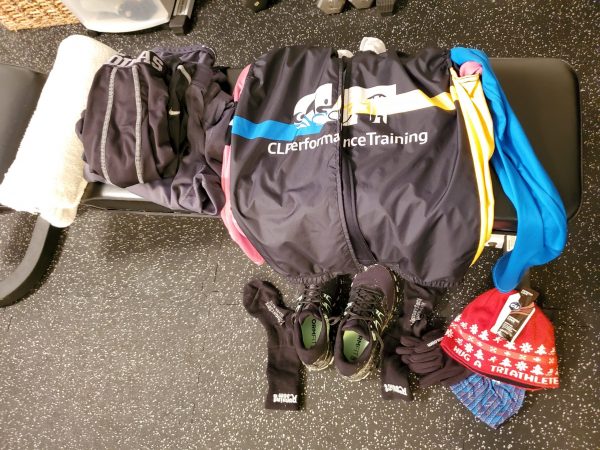– by Coach Nick LeClair
A brick workout. Three simple words that when separate don’t mean much, but when strung together, become a very popular workout for triathletes to complete. For those unfamiliar with the term, a brick workout refers to completing a bike workout then transitioning directly to a run workout. Although it may sound simple in theory, the trick is to master the transition between the bike and run while motivation remains high. Below are three tricks I highly recommend implementing to master that brick transition in a Canadian winter.
1. Dry-off towel
During the summer season it is very easy to complete the run in the same outfit you completed your bike workout in. Considering the Canadian winter can get very cold the addition of clothing is necessary for health and comfort. Although this may seem simple, try putting on a long sleeve shirt and tights while soaked in sweat – not easy! This is where the dry-off towel comes in handy. I highly recommend putting a clean towel on the top of your transition set up to allow yourself to wipe off the sweat accumulation from the bike. The sweat will come back since you just completed a workout but the magic is getting the base layer on before that happens. Once you have done this then any additional layers you want to put on is business as usual.
2. Effective layering
There is no such thing as poor training weather, just poor training gear. This tip goes hand in hand with the first tip. Having the correct type of layering results in less of a struggle trying to get dressed while hot and sticky. I recommend breaking your layers down by purpose: sweat, warmth, and wind. An example of effective layering would be to have articles of clothing with heat/ thermal technology built into them to allow you to have fewer layers within, while not sacrificing warmth to battle the fridged weather outside. A general guide you can follow is: Base layer = sweat collecting, 2nd layer = thermal wear, 3rd layer = wind proof gear. Each layer serves a purpose and when combined all together you have the perfect combination to tackle the cold. Downloading a weather app is a great tool to aid with determining what layers you need and goes in depth about temperature, wind speed, windchill, and real feel temperature. Since you are fresh off the bike, it is easy to fall in the trap of forgetting layers because you are feeling hot indoors.
3. Preparation
I would consider this the secret sauce to a quick and effective transition. There is nothing worse than having to scramble around to six different places trying to obtain all the gear in a limited amount of time. This is also an amazing tool to use to practice setting up a transition zone that you would use in a race. My recommendations is to think about the order you are putting on your gear and create a stack. Your body can only execute one action at a time, so create a “checklist” with the order you stack your gear. Shoes go on last therefore should be at the bottom. Socks – if you wear them – have to go on before the shoes so place the socks on top of your shoes. The order of tops and pants will depend on your personal preference but think about the order of each layers! Your base later should be at the top with the other layers below it. Bringing the whole transition station to a close, place the dry-off towel at the very top and maybe some gels & bottles to the side for a quick grab and go. Try for a target time of five to ten minutes.
Use each transition as a learning experience. During the run portion or after the brick briefly reflect on what worked, what didn’t work, and what you wish you had included. This information allows you to continuously improve the transition from brick to brick and eventually to race.
There is already enough to dread about a brick workout but your winter transition should not be one. You are not alone with the struggle. Using the three tips above should allow you to instantly see improvement in your next brick transition. Best of luck and train smart.



